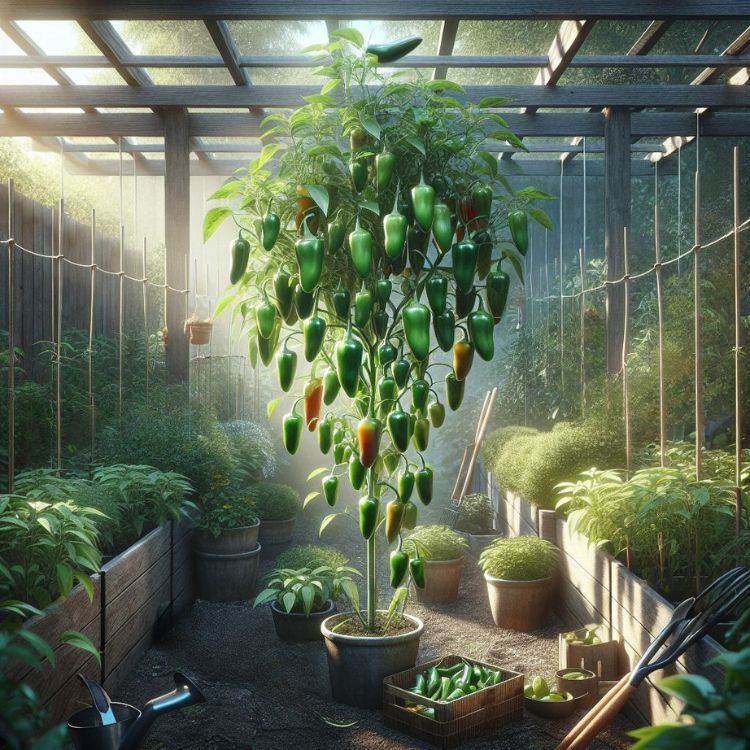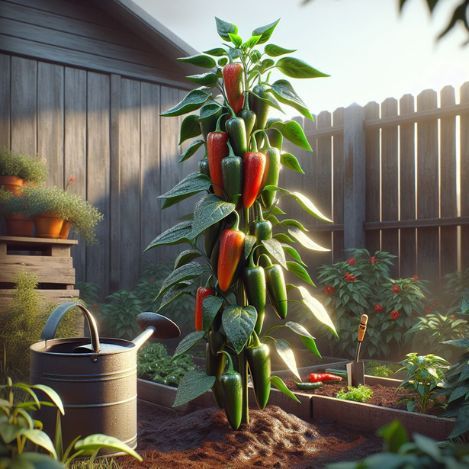
There’s something truly rewarding about growing your own food, especially when it adds a kick to your meals like the early jalapeno pepper does. Whether you’re a seasoned gardener or a green-thumbed newbie, these spicy gems are perfect for adding heat to your dishes and versatility to your garden.
Key Takeaways
Early jalapeno peppers are ideal for shorter growing seasons and cooler climates.
Starting seeds indoors 8-10 weeks before the last frost date gives your peppers a head start.
Proper soil preparation, consistent watering, and full sun are crucial for healthy growth.
Harvesting at the right time ensures maximum flavor and spice.
Organic and heirloom seed options are available for those looking to add early jalapenos to their survival garden.
Why Early Jalapeno Peppers Belong in Your Survival Garden
Imagine a garden that not only feeds your family but also fortifies your meals with vibrant flavors. Early jalapeno peppers are a must-have in any survival garden. They mature quickly, which means you get to enjoy the fruits of your labor sooner, and they’re resilient, thriving in a variety of climates. They’re not just about the spice—they’re packed with vitamins and can be preserved to last through the winter. Let’s dive into what makes these peppers so appealing.
The Appeal of Jalapeno Peppers
Jalapeno peppers are the go-to for a reason. They have the perfect balance of heat and flavor that can be enjoyed fresh, cooked, or preserved. Besides that, they’re incredibly nutritious, rich in vitamins A and C, and they can help boost your metabolism. Most importantly, they are versatile in the kitchen, making them a favorite among gardeners and chefs alike.
Brief History and Characteristics
The jalapeno is a pepper with deep roots in Mexican cuisine, its name hailing from Xalapa, Veracruz, where it was traditionally cultivated. It’s a pod type of Capsicum annuum, and its heat can vary from mild to hot, depending on the cultivation and preparation. Early jalapenos are a specific variety that matures faster, making them ideal for gardeners in cooler climates or those who are simply eager to harvest.
Getting Started with Early Jalapenos
Starting your own early jalapeno plants is like embarking on a spicy adventure. The journey from seed to harvest is filled with learning and anticipation. Let’s get you started on the right path.
Choosing the Right Seeds
When selecting seeds for your early jalapenos, you have two excellent choices: organic or heirloom. Organic seeds are certified to be free from synthetic fertilizers and pesticides, ensuring a natural growth process. Heirloom seeds, on the other hand, are passed down through generations and often yield more flavorful peppers. Whichever you choose, you’re making a great addition to your survival garden.
Preparing Your Garden Space
Before you plant your early jalapeno seeds, your garden space needs to be prepped. These peppers love the sun and require well-drained soil rich in organic matter. Here’s how you can create the perfect home for them: maximize your garden space with effective techniques.
Choose a sunny spot that receives at least 6-8 hours of sunlight per day.
Work compost or aged manure into the soil to improve fertility and drainage.
Ensure the soil pH is between 6.0 and 6.8 for optimal nutrient uptake.
Nurturing Your Peppers to Perfection
Once your early jalapeno seedlings have sprouted and you’ve transplanted them to their sunny spot, the real magic begins. It’s not just about watching them grow; it’s about providing the care they need to flourish. With the right techniques, you’ll be well on your way to a bountiful harvest.
Consistency is key in pepper care. These plants don’t like to be drenched, but they do need a steady supply of moisture, especially as the fruits start to form. A good rule of thumb is to water deeply once a week, but adjust as needed based on temperature and rainfall.
Soil, Sun, and Water: The Essentials
Early jalapenos love the sun, so make sure they’re in a spot where they can bask in its glory for most of the day. They’re not as thirsty as some plants, but they do need regular watering. The goal is to keep the soil consistently moist but not soggy. Overwatering can lead to root rot, while underwatering can stress the plant and affect the heat of your peppers.
Water at the base of the plant to avoid wetting the leaves, which can lead to fungal diseases.
Use mulch to help retain soil moisture and regulate temperature.
Check the soil before watering; if the top inch is dry, it’s time to water.
Remember, soil quality can make or break your pepper plants. Early jalapenos prefer a well-draining, nutrient-rich soil. If you’re working with heavy clay or sandy soil, amend it with compost to improve texture and fertility.
When and How to Fertilize
Peppers are relatively light feeders, but they’ll benefit from a little nutritional boost. Start with a balanced, slow-release fertilizer when you plant them. As they grow, you can supplement with a low-nitrogen, high-phosphorus fertilizer to encourage fruiting. Be careful not to over-fertilize, as this can lead to lush foliage but few fruits.
Here’s a simple fertilizing schedule to follow:
Apply a balanced fertilizer at planting time.
Once the first fruits set, switch to a low-nitrogen, high-phosphorus fertilizer.
Feed every 4-6 weeks, following the instructions on the fertilizer package.
Pest and Disease Management
Like any garden plant, early jalapenos can encounter pests and diseases. Keep an eye out for common culprits like aphids, spider mites, and pepper weevils. If you spot them, act quickly with an appropriate organic pesticide or natural remedy like neem oil or insecticidal soap.
Prevent diseases by practicing crop rotation and providing good air circulation around your plants. If disease does strike, remove and destroy affected plants to prevent it from spreading.
The Harvest: Picking and Preserving Your Peppers

The moment you’ve been waiting for: harvest time! Early jalapenos set the stage for a season of spicy delights. Picking your peppers at the right time is crucial for flavor and heat. You’ll know they’re ready when they’re firm, glossy, and have a deep green color. If you prefer a milder taste, harvest them a little earlier. For more heat, leave them on the plant longer or until they start to turn red.
Harvesting your peppers isn’t just about timing; it’s also about technique. Use a sharp pair of scissors or pruning shears to cut the peppers from the plant, leaving a short stub of stem attached. This helps prevent damage to the plant and keeps your peppers fresher for longer.
Identifying the Right Time to Harvest
Here’s how to know when your early jalapenos are ready to pick:
Check the color – a vibrant green usually indicates they’re ready.
Feel the firmness – they should be firm but not hard.
Look for a size of about 3 inches long – that’s the sweet spot for early varieties.
Harvesting at the right time not only ensures the best flavor but also encourages the plant to produce more peppers. It’s a win-win!
Storing and Preserving Techniques
After you’ve picked your peppers, it’s time to think about storage and preservation. Fresh jalapenos will keep in the refrigerator for a week or two, but for long-term storage, consider freezing, drying, or pickling them.
Freezing: Slice or dice your jalapenos and spread them on a baking sheet to freeze individually. Once frozen, transfer them to a freezer-safe bag.
Drying: Hang whole peppers in a dry, well-ventilated area or use a dehydrator. Store dried peppers in an airtight container.
Pickling: Preserve your jalapenos in vinegar with spices for a tangy treat that lasts for months.
Whether you’re adding them to a salsa, spicing up a stir-fry, or storing them for future use, early jalapenos are a flavorful and fulfilling addition to your survival garden. Now that you’re armed with the knowledge of how to grow, nurture, and harvest these piquant peppers, it’s time to get planting!
Frequently Asked Questions (FAQ)
Gardening can be full of surprises and learning experiences, especially when it comes to growing early jalapeno peppers. Let’s address some of the most common questions that might pop up as you cultivate your spicy survival garden.
How long does it take for early jalapeno peppers to mature?
Early jalapeno peppers are known for their quick maturation. Generally, from the time you transplant your seedlings, you can expect to see mature peppers in about 72 days. This can vary slightly based on growing conditions and care, but the ‘early’ in their name stands true to the quick turnaround from plant to plate.
Remember, patience is key! The wait will be worth it when you’re savoring the fruits of your labor.
If you’re eager to see results, starting your seeds indoors can give you a head start on the growing season. Just make sure to acclimate your seedlings to outdoor conditions gradually before planting them in their permanent spot.
Are early jalapeno peppers perennials or annuals?
Early jalapeno peppers, like most pepper varieties, are typically grown as annuals. They complete their life cycle in one growing season. However, if you live in a region without frost, they can sometimes be treated as perennials and will continue to produce for several years. For most gardeners, though, you’ll be planting new seeds or seedlings each year.
Can early jalapeno peppers be grown in containers?
Absolutely! Early jalapeno peppers are well-suited for container gardening. This is especially beneficial if you’re short on space or want to control the growing conditions more closely. Here’s what you need to know:
Choose a container that’s at least 10-12 inches deep and has good drainage.
Use a high-quality potting mix to ensure proper nutrition and drainage.
Place your container in a spot that receives full sun for the majority of the day.
Container gardening also makes it easier to bring your plants indoors if a sudden cold snap threatens your crop. Just be sure to provide plenty of light and maintain consistent watering practices.
What should I do if my jalapeno peppers are not spicy?
Heat levels in jalapeno peppers can vary due to several factors. If your peppers aren’t packing the punch you expected, consider the following:
Stress can increase capsaicin levels in peppers, so a little controlled stress, like irregular watering, can make them hotter.
Allowing the peppers to mature fully on the plant can also enhance their spiciness.
Soil nutrients, particularly nitrogen levels, can affect heat. Too much nitrogen can result in less spicy peppers.
Experiment with these tips, and you might just find the extra heat you’re looking for.
How can I save seeds from my jalapeno plants for next season?
Saving seeds from your jalapeno plants is a great way to continue your gardening journey and maintain the varieties you love. Here’s how to do it:
Pick a healthy, mature pepper from your plant and slice it open. Carefully remove the seeds and spread them out to dry on a paper towel or plate. Store them in a cool, dry place until you’re ready to plant them next season.
One thing to keep in mind is cross-pollination. If you’re growing multiple pepper varieties, they can cross-pollinate, and the seeds may produce plants that are different from the parent. If you want to ensure true-to-type plants, only save seeds from isolated plants or use blossom bags to prevent cross-pollination.
And there you have it! With these tips, you’re ready to grow early jalapeno peppers that will add zest to your meals and resilience to your garden. Happy gardening!
Early Jalapeno peppers are a fantastic addition to any survival garden. These peppers are not only flavorful but also boast a variety of uses, from spicing up meals to potentially being used as a natural pest deterrent. Starting a survival garden with Early Jalapeno peppers can be a fun and practical way to ensure a steady supply of fresh produce in uncertain times.







Leave a Reply